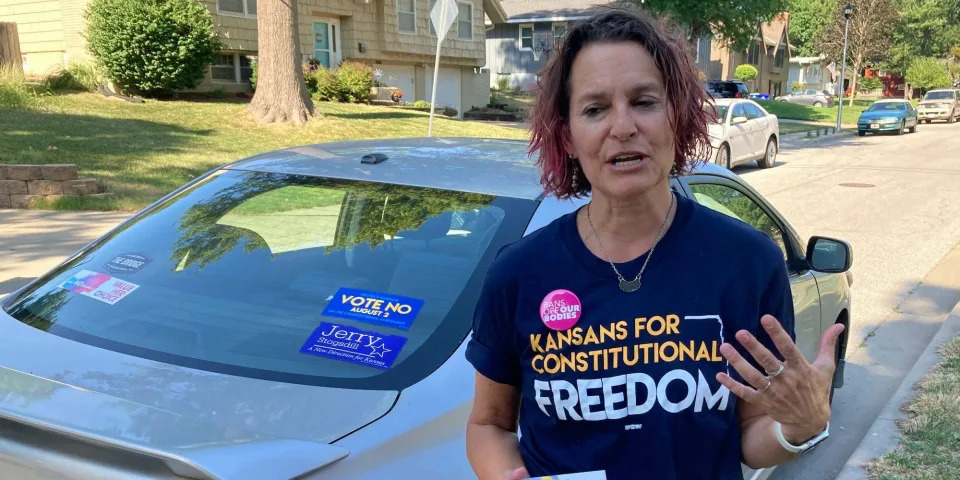Wed, August 3, 2022

In a story playing out in rural communities across Canada, Grand Manan's only brick-and-mortar bank branch will be closing permanently. (Julia Wright/CBC - image credit)
Grand Manan is home to scenic coastline, an active fishery, pebble beaches — and small businesses ranging from take-outs and coffee shops, to convenience stores and art galleries, serving a year-round population of about 2,400.
But after Aug. 24, there's one key amenity Grand Manan won't be able to offer — a bank.
Scotiabank announced in January its intention to close its Grand Manan branch, the only bank on the island for over 100 years, and shut down the island's only ABM as well.

Roger Cosman/CBC
"I truly thought it was a joke at first," said Selena Leonard, while making a cash deposit at the bank. "I thought it was just one of those things that you see on Facebook that are just not true."
"It became kind of like a nightmare when we found out it was true."
Leonard and her husband live on the island, where they own two restaurants.

Roger Cosman/CBC
So close, yet so far
She says a full day of travel, plus meals, to do routine banking is out of reach for most people on the island, many of whom would have to take a day off work.
In the summer Coastal Transport runs two ferries, with two hours between each trip. The rest of the year, there are four hours between trips and one ferry.
"There are quite a few people that do online banking — but a lot of our population are seniors that don't, and not all of them would have a family that could help them out," Leonard said.

Julia Wright/ CBC
For some, that would mean having to "hire someone to take them away to the mainland. Then they have to feed them, pay for the boat fare, and pay that person to go and deposit, like $100, or their seniors' cheque or whatever."
Tabitha Bainbridge was withdrawing cash at the Grand Manan Scotiabank with her aunt, who is in her late 80s and lives in the island's North Head village.
"This, sadly, I guess, is going to be the last time I visit the bank to withdraw some money. I'm not happy about it all," Bainbridge said.

Roger Cosman/CBC
Her aunt "doesn't do smartphones. Even though we try to convince her, she doesn't have a computer, she doesn't use a bank machine, so she can't go 45 minutes to St. George every time she needs to pay her bills."
"Like many of the seniors here in person, they bring in their bill and they pay it in person. So it's ridiculous that they're talking about leaving this island without a bank," Bainbridge said.
A series of workshops, called Digital Days, have been held at the bank branch for anyone who needs help learning to use the alternatives such as online and telephone banking.
The next session will be on Aug. 11.
Theft, attracting new businesses a concern
Leonard also worries businesses with large quantities of cash on hand could be enticing to certain shady customers.
"I'm scared for our business, and other business owners. Our homes and our businesses will have, kind of, big bullseyes painted on them. 'Oh, come rob me because we have cash.'"

Roger Cosman/CBC
"I'm not looking forward to that. Just a little bit of fear and anxiety about that," she said.
The mayor is also concerned about future prospects for the island, wondering if businesses considering setting up on Grand Manan might not want to do so without a financial institution.
Town halls, protests
Grand Mananers have tried everything to get Scotiabank to reverse the decision.
There have been heated town halls, and peaceful protest. One resident, Gregg Russell, went all the way to Toronto and staged a one-man picket outside Scotiabank headquarters on King Street W.

Submitted by Gregg Russell
John Williamson, the Conservative MP for the area, set up a meeting between Grand Manan Mayor Bonnie Morse and members of the federal finance department, including a policy advisor to Chrystia Freeland.
"They were very well briefed on our issues, but really their scope, or their ability to do anything about the bank closure is pretty limited," Morse said.
WATCH | Why some Grand Manan residents may not be able to switch to online banking:
Mayor Morse says the village council is meeting with local businesses to determine what they need, and its Economic Development Committee is working on finding potential options. But there have been no concrete answers.
The loss of brick-and-mortar banks is a story playing out in rural communities across Canada.
In New Brunswick, Scotiabank also closed its historic branch in the village of Bath, population about 500, in July.
More branches in PEI and in rural Nova Scotia will also close in the coming months.

Julia Wright/ CBC
'What in heaven's name are you thinking?'
The uncertainty is hard for people on Grand Manan who remember a time when banks and other businesses felt more connected to their community and saw customers as more than "just numbers on a page," as Leonard put it.
"This decision has been made as a result of a fulsome business review," the bank said in a statement. "We feel that this relocation will help us provide better service and greater resources to our customers in both the Grand Manan and St. George communities."
Selena Leonard isn't buying that. She has a question for the Scotiabank officials who made the decision to close the bank.
"What in heaven's name are you thinking?"
"It's just a number on a page from an office where they have no idea of the remoteness and the uniqueness of the island — how difficult, and inconvenient, it is for people here to get away," she said.
"We've been faithful to you. It's your turn."



























